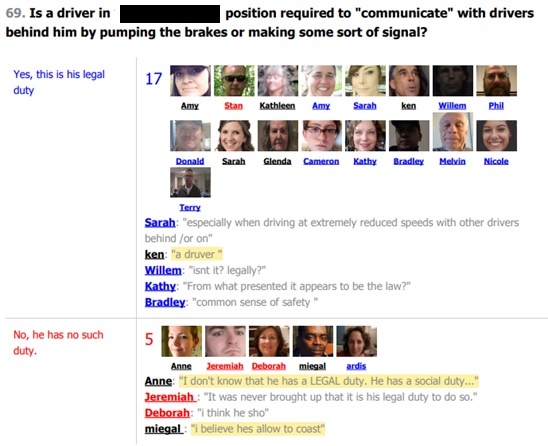
Consider this fact pattern and outcome from a case we recently worked on: Plaintiff rear-ends trailer pulling a large load of logs. I repeat: Plaintiff rear-ends defendant. But the jurors assign most of the blame to the defendant… who was rear-ended.
Juror's Feedback:

This outcome is incredibly common. Why? The plaintiff attorney in this case engaged the jurors' emotions and gave them the need to help the plaintiff... from the beginning of the voir dire. The jurors then ignored all the instructions about how the law requires drivers to control their own vehicles . . . and instead found that drivers have a legal duty to warn cars behind them!
The moral of the story? Jurors will ignore real law, and make up fake law, in order to follow their emotions. As one federal judge tells his lawyers in settlement discussions: “Give me good damages and I don’t need liability.”
Here’s what our best lawyers do about this. First, they understand that it is naive to think that jurors will follow (or even understand) the jury instructions. Instead, they take time in their trial prep to answer this question:
How do I engage these juror's emotions?
Successful lawyers, both plaintiff and defense, then create a compelling emotional frame of reference for the case… before saying a word about the substance of the law. They do this first in voir dire. Don't wait for opening arguments, and certainly not for your closing. Secure the juror's emotional buy-in from the get-go, then spend your case channeling it towards a winning verdict.
We have seen countless examples of this reality playing out in our jury research projects. Contact us to learn more about how we have helped attorneys win their juror's hearts AND minds.
Recent Articles by Our First Court Team:
- Managing Your Greatest Asset: Time
- In Light of the Election: How Does Today’s Political Climate Affect the Jury?
- Exploring the Rewards of Mediation
- How Lawyers Can Start Building a Social Media Presence With Confidence
- Understanding Proximate Cause in Legal Defense
- A Trial Lawyer’s Guide to Serving Red Herring
- Two Things Can Be True Simultaneously: Learning to See Through the Eyes of a Juror
Tags:
ADR, Settlement, Jurors, Voir Dire, Advocacy, Jury Research, Focus Group, Deposition, Emotion, Law, Experts, jury trial, jury selection, Mediation, jury verdicts, Arbitration
Oct 17, 2018 10:49:27 AM




Comments